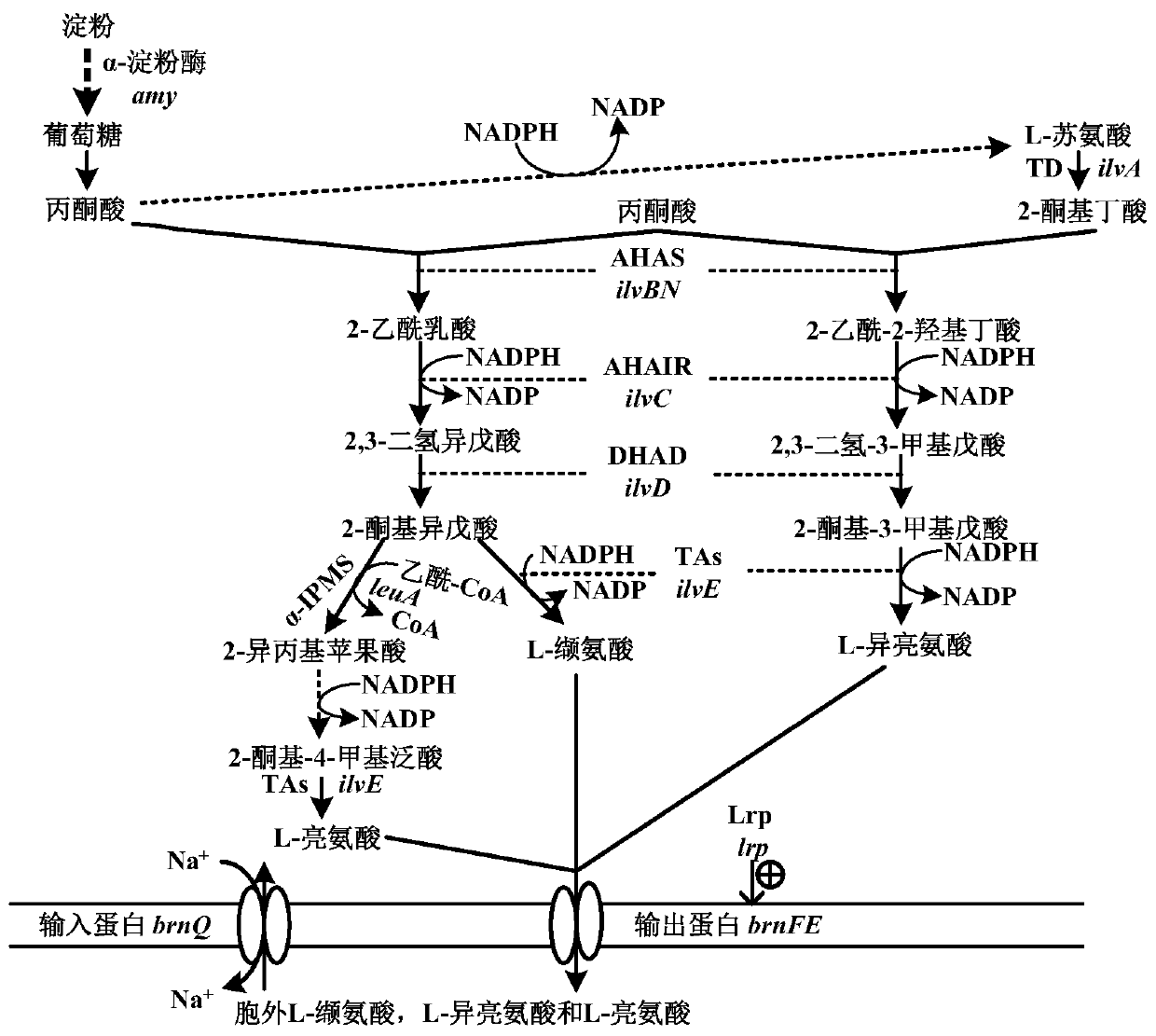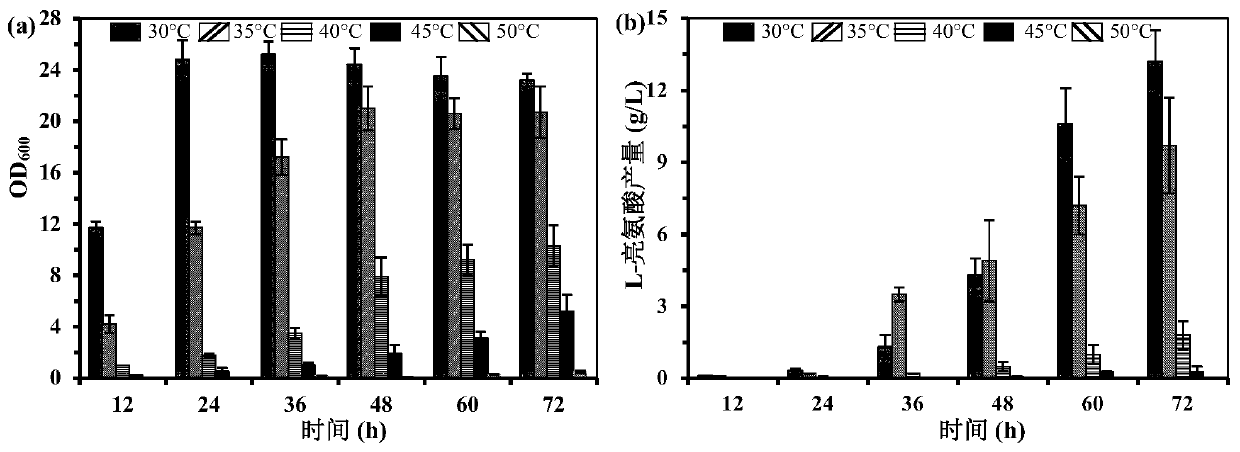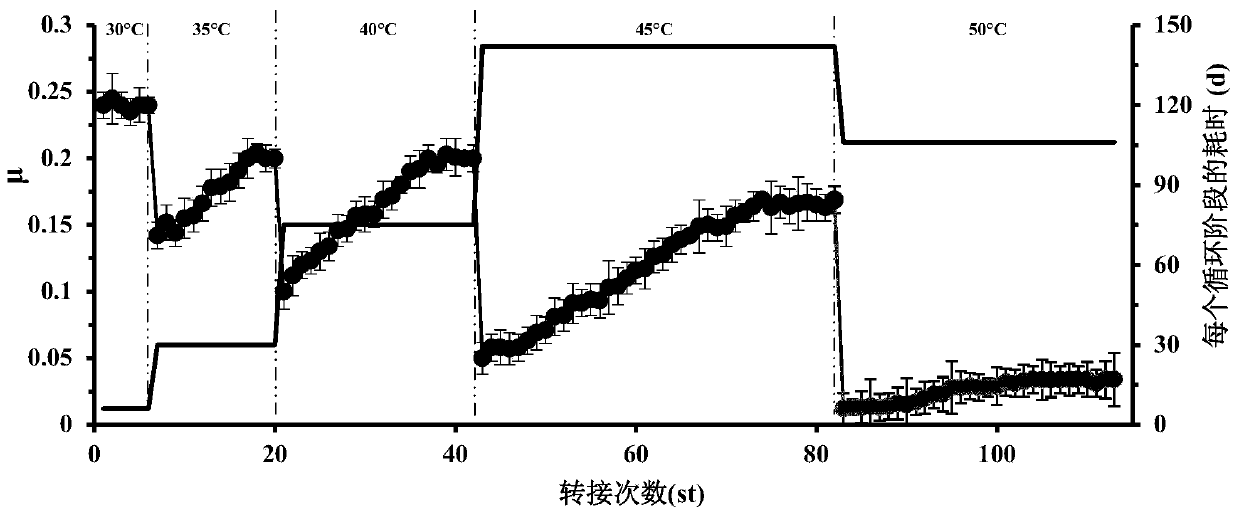Method for producing L-leucine by efficiently utilizing starch
A technology of leucine and starch, which is applied in the direction of using microorganisms, methods based on microorganisms, biochemical equipment and methods, etc., can solve the problems of inability to realize industrial application, achieve the improvement of inconsistent optimum action temperature, and improve the durability receptive effect
- Summary
- Abstract
- Description
- Claims
- Application Information
AI Technical Summary
Benefits of technology
Problems solved by technology
Method used
Image
Examples
Embodiment 1
[0036] Example 1: Growth rate and L-leucine output of starting strain XQ at different temperatures
[0037] The starting strain XQ was inoculated in the fermentation medium, and cultured in shake flasks at 120r / min at 30°C, 35°C, 40°C, 45°C and 50°C for 72h, and samples were taken regularly to measure the OD at different culture temperatures 600 and L-leucine production. The results are as follows figure 2 shown.
Embodiment 2
[0038] Example 2: Adaptive evolution means gradually acclimating the temperature tolerance of the starting strain XQ
[0039] The acclimatization operation process and the change of specific growth rate under each cycle temperature are as follows: image 3 As shown, it specifically includes: first, inoculate the starting bacterial strain XQ in LBG liquid medium and culture it in a 120r / min shake flask at 30°C, and measure the specific growth rate μ=χ of the starting bacterial strain XQ at 30°C 0 . Next, take 1% of the culture solution of the starting strain XQ that was cultured in shake flasks at 30°C to the middle and late stages of logarithmic growth in a Erlenmeyer flask filled with fresh LBG liquid medium, and culture in shake flasks at 120r / min at 35°C , Determining the specific growth rate of strain XQ at 35°C μ = χ 1 . Subsequently, absorb 1% of the culture solution of the starting strain XQ that was cultivated at 35°C to the middle and late logarithmic growth stages...
Embodiment 3
[0040] Example 3: Screening of the best target bacterial strains at different temperatures
[0041] Take the screening of the best target strain at 35°C as an example.
[0042] When the strain has a specific growth rate μ≈χ at 35°C 0 At this time, an appropriate amount of bacterial solution in the mid-logarithmic growth phase was drawn and diluted, spread on the LBG solid culture plate and incubated at 35°C until a single colony grew. A single colony with a large colony on the LBG plate was randomly selected, inoculated in the glucose fermentation medium, and cultured in a shaker flask at 120 r / min at 35°C for 72 hours, and the production of L-leucine of different mutant strains was measured. Through screening, the mutant strain L35-39 with the highest L-leucine production at 35°C was finally obtained. Subsequently, using the mutant strain L35-39 as the starting strain, continue to screen the mutant strains L40-27 and L45-52 with high L-leucine production at 40°C and 45°C. T...
PUM
 Login to View More
Login to View More Abstract
Description
Claims
Application Information
 Login to View More
Login to View More - R&D
- Intellectual Property
- Life Sciences
- Materials
- Tech Scout
- Unparalleled Data Quality
- Higher Quality Content
- 60% Fewer Hallucinations
Browse by: Latest US Patents, China's latest patents, Technical Efficacy Thesaurus, Application Domain, Technology Topic, Popular Technical Reports.
© 2025 PatSnap. All rights reserved.Legal|Privacy policy|Modern Slavery Act Transparency Statement|Sitemap|About US| Contact US: help@patsnap.com



